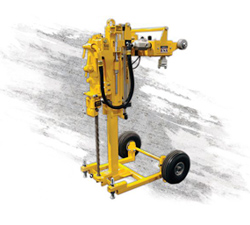It’s a fact: The risk of a gas leak is very real. Even though gas lines are underground, they endure many environmental factors, from temperature changes to deterioration, which over time can impact their integrity.
When a leak happens, contractors must locate it quickly, and the safest most efficient way to do that is by drilling holes, taking a reading and repeating this process until the highest gas levels are detected. Then the process of opening up the section for repairs can begin.
Choosing a drill to do the job is not quite as universal as the drilling approach, however. There are a few different drilling units that can get the job done, but the ideal method is one that ensures the safety of operators and bystanders.
 We designed the 20 UTL utility drill to do just that. It can be placed in the back of a van or truck so contractors can head to the site quickly. Thanks to its frame-mounted design and weight, the drill has ample stability to drill holes without requiring an operator to hold it. This means no vibrations are transferred to an operator’s hands or arms so there is no risk of repetitive strain injuries. In fact, the 20 UTL is rated for use as long as 12 hours during a workday with no risk of injuries; that’s 11.5 hours longer than a handheld rock drill!
We designed the 20 UTL utility drill to do just that. It can be placed in the back of a van or truck so contractors can head to the site quickly. Thanks to its frame-mounted design and weight, the drill has ample stability to drill holes without requiring an operator to hold it. This means no vibrations are transferred to an operator’s hands or arms so there is no risk of repetitive strain injuries. In fact, the 20 UTL is rated for use as long as 12 hours during a workday with no risk of injuries; that’s 11.5 hours longer than a handheld rock drill!
Why does all this matter? Just one workers’ compensation claim can cost employers thousands of dollars. Employers also could be paying more when it comes to labor, as well. Operators using handheld and lightweight frame-mounted drills are limited to specified number of hours before they must be replaced with a fresh operator.
Read how one gas company went from 14 injuries in one year to zero after purchasing 20 UTLs for its crew. Then, let us know your questions and how we can help your business lessen injuries and increase productivity.

